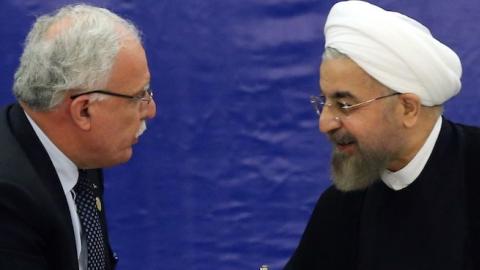Ninety minutes into the 72-hour unconditional ceasefire announced this morning, Hamas launched a suicide attack in which two IDF soldiers were killed and another was kidnapped. Word on the ground in Israel is that Palestinian Islamic Jihad, rather than Hamas, may be responsible for the operation. If those rumors prove accurate, some analysts speculate, it would mean that Iran, PIJ’s longtime patron, is behind the operation and is responsible for scuttling the ceasefire.
The reality is that regardless of PIJ’s involvement, it is virtually certain that Iran played a large role in this morning’s operation. Mounting evidence points to the fact that Hamas’s nearly month-long campaign, now bracketed by the kidnapping and murder of three Israeli civilians and the killing and the kidnapping of IDF soldiers, was an Iranian project from the beginning.
As Iran analyst Ali Alfoneh noted yesterday, “Arm Hamas . . . was the main message of Supreme Leader Ali Khamenei’s speech on the occasion of Eid al-Fitr, the feast marking the end of the month of Ramadan.” Support for Hamas marked a shift in Khamenei’s rhetoric, as Alfoneh explains. Relations between Hamas and Tehran have been chilly ever since the two parties came down on different sides of the Syrian conflict, with Iran fully backing its client Bashar al-Assad and Hamas wary of supporting a brutal suppression of their Sunni co-religionists.
But both sides have been trying to mend relations for some time. Hamas needs Iranian money and arms, and with Hezbollah spread increasingly thin fighting in Syria as well as Iraq, the clerical regime needs to shore up its deterrence against Israel. Hamas’s campaign over the last month was effectively a tryout to rejoin Team Iran.
As Tony Badran, a research fellow at Foundation for Defense of Democracies, explains in an important column for NOW Lebanon today, Iran and Hamas have been clearly signaling each other during the conflict.
“After the war broke out,” Badran writes, “senior Iranian officials, including Quds Force commander Qassem Soleimani, expressed strong support for the leaders of Hamas and Islamic Jihad. Hezbollah Secretary General Hassan Nasrallah also phoned the head of Hamas’s politburo, Khaled Meshaal, and Islamic Jihad chief Ramadan Shallah. Iran's relationship with Hamas has been strained for the past couple of years, so these statements mark a reinvigoration of the ‘Resistance Alliance.’ The rebirth of the Iranian-led axis provides the essential ingredient for a new explanation of Hamas's decision to go to war with Israel.”
The Gaza conflict should come as a sharp reminder that what we’re watching unfold in the Middle East at present is less a region-wide Sunni-Shiite war but rather a regional cold war where sectarian conflict and the rise of sub-state actors is a byproduct of a larger struggle between real nation states, often fighting through proxies. On one side are traditional American allies or partners like Egypt, Saudi Arabia, United Arab Emirates, Jordan, the Palestinian Authority and Israel. This is the status quo camp that wants to preserve the U.S.-backed order of the Middle East, a task increasingly difficult with the Obama administration all but absent from the region.
Iran and the resistance axis, including Assad, Hezbollah, Iraqi Shiite militias and even Iraqi prime minister Nuri al-Maliki are on the other side. Turkey and Qatar are somewhere in the middle, looking to make themselves relevant, like by backing the Muslim Brotherhood. In the Gaza conflict, Doha and Ankara are acting as Hamas’s lawyers, for instance presenting John Kerry with the pro-Hamas terms for a ceasefire agreement last week. However, their attempts at mediation notwithstanding, Qatar and Turkey are secondary players. Yes, Khaled Meshaal lives in Doha, but Hamas’s political officials aren’t directing the war on the ground. Rather, it’s in the hands of Hamas’s military commanders, like Mohamed Deif Marwan Issa.
As Jerusalem Center for Public Affairs research associate (Ret.) Brigadier General Shimon Shapira told me recently, Iran has gone over the heads of the politburo officials and reached out directly to the military commanders. If Meshaal can afford the luxury of tending to his garden in his lovely Doha home, it’s different for the organization’s military commanders that have to pay and feed men to maintain their own power on the ground. There’s war in Gaza because the interests of Hamas’s men in uniform are aligned with those of the clerical regime in Tehran. As Badran writes, the war “was a necessary gateway for Hamas to resume its place in the resistance axis.” The current conflict, Badran concludes, “has served to clarify Hamas’s mission and place on the regional map.” In short, it has returned to the Iranian fold.
The key question then is why did Tehran plot an operation—the abduction of an IDF officer—that was certain not only to scuttle the ceasefire but also further steel Israel’s will, while making it nearly impossible for the Obama administration to restrain the Netanyahu government? After Israel’s 2006 war with Hezbollah, Operation Cast Lead in Gaza in 2009, and most recently 2012’s Operation Pillar of Defense in Gaza, Iran’s proxies didn’t throw gas on the fire as Hamas did this morning. What’s different this time around?
Insofar as it is a regional cold war, the reality is that Iran’s proxy in Gaza has few real triumphs. Yes, Hamas kidnapped and killed three Israeli teenagers in June. With the assistance of the FAA, it virtually closed down Ben Gurion airport for 48 hours. It also fired hundreds of missiles on Israel and its attack tunnels will feed the nightmares of Israeli officials and parents for many years to come. To date, some 60 IDF troops have lost their lives.
Now consider the other side of the ledger: The Iron Dome succeeded in deflecting the vast majority of missiles. As of yesterday, the IDF claimed that 90 percent of Hamas’s attack tunnel network was destroyed, as was half of its missile arsenal. Further, the IDF assesses that Operation Protective Edge has killed some 1,000 Hamas fighters. Even the ceasefire presented terms unfavorable to Hamas, since, among other things, it allowed Israel to continue destroying tunnels. In short, Hamas comes out of the conflict a clear loser. However, the operation this morning represents a tangible victory, a kidnapping that Hamas and its Iranian backers understand from experience will eat at the Israeli public.
The dominant issue however is the strategic picture. The P5+1 has extended the interim agreement with Iran until November when it hopes to reach a permanent deal over the nuclear weapons program. From this perspective, the war in Gaza is, first, a delaying tactic meant to get the nuclear issue off the front page. Second, and most important, it’s a threat: Iran can turn up the heat around the region, from Iraq to Gaza, at will. The problem for America’s traditional allies is that those hot spots are on their borders—Israel, for instance, now has Iran on three of its frontiers: Lebanon, Syria, and Gaza. An even graver concern for our allies is that the White House still seems incapable of understanding the nature of the regime in Tehran.
















